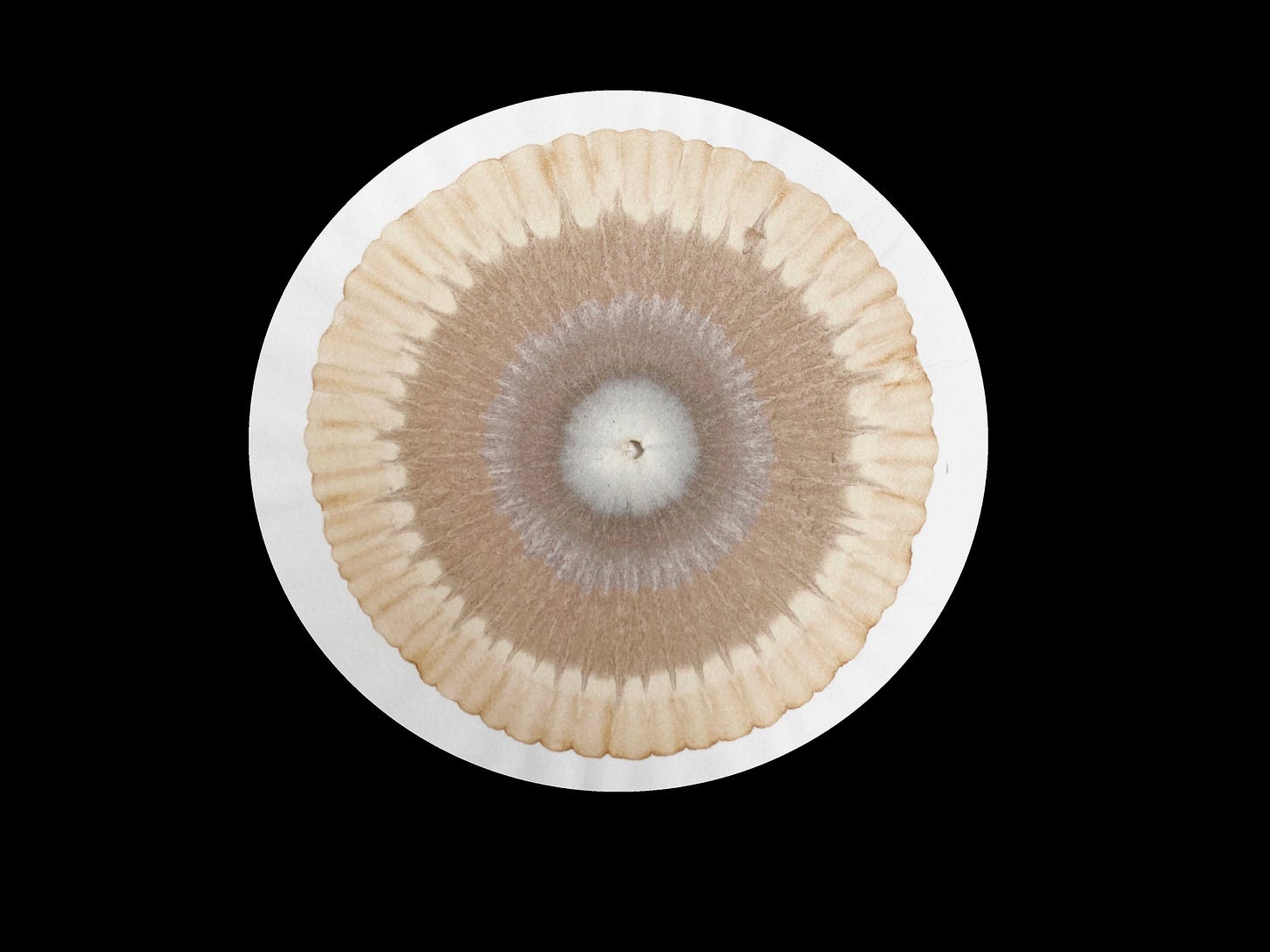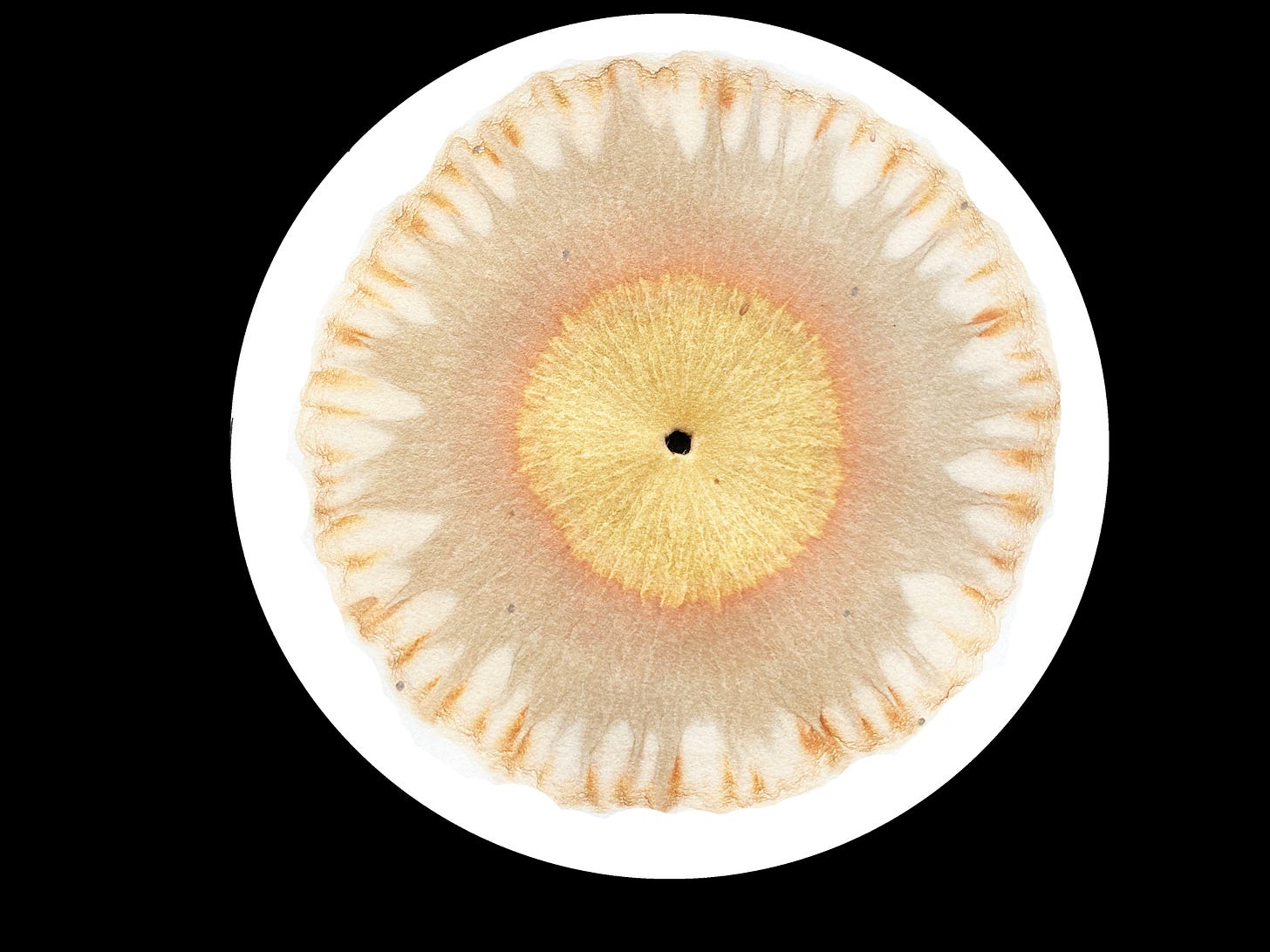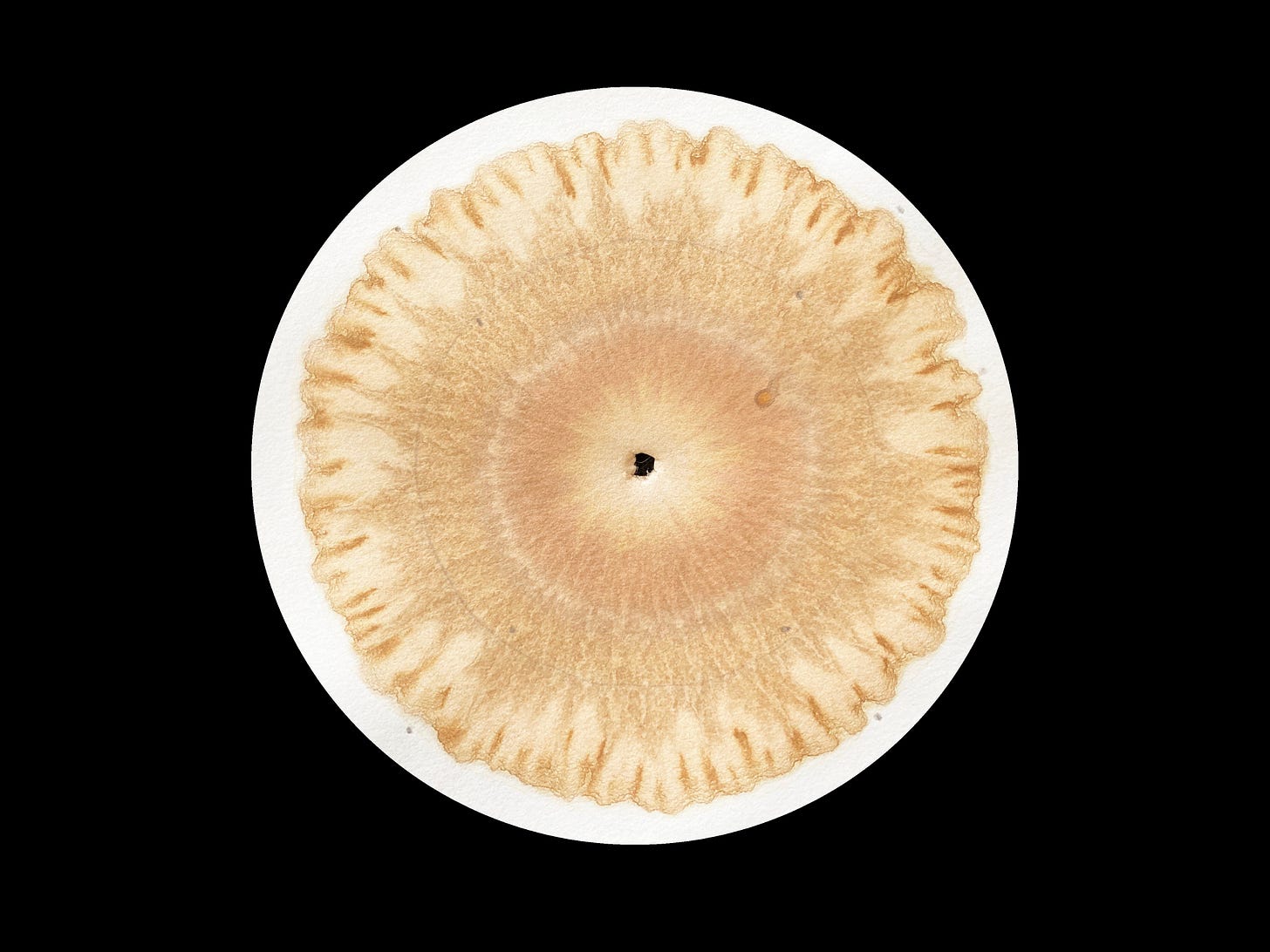Most often, when trying to answer questions about something occurring in our plants or soils, we turn to a few methods of approach: observation, empirical science, our past experiences, and personal instinct. Within the biodynamic approach, this equates to listening to our intellect, heart, and gut – a Threefold approach. That’s usually a good foundation to begin figuring out what may be going on with our plants and soils. But inevitably, questions remain while we are deciding how to move forward in each unique circumstance: “is my compost lacking in some necessary nutrients?” “why does this area of the farm grow stunted crops?” “do I make quality biodynamic preparations?”
Chromatograms, if interpreted correctly, can often answer these questions. They give us an opportunity to fold back the veil that hides the unseen inner workings of nature.
What exactly is a chromatogram? Chromatograms are pictorial examples of the physical and etheric forces that are moving through natural substances such as soil, compost, plants, or biodynamic preparations. The substance is soaked in a salt solution and then leached onto filter paper that has been impregnated with silver nitrate. This is a light-sensitive process. The chromatogram is then allowed to develop over a period of 3-5 days in daylight.1
The process then has a second step: the proper interpretation of the chromatogram. Knowing what the visual signals are is essential in gleaning the information that has been unveiled. And the information a chromatogram provides can be fascinating.
Until recently, a predominantly compartmental method has been used for interpretation. This method gives us information on the quality of minerals, water-holding capacity, and the humus content of a preparation or substance. Thanks to Dewane Morgan of Midheaven Farm2, an etheric method has now been developed adding another dimension to what our chromatograms are telling us. The etheric approach allows us to interpret the etheric forces present in the preparation or substance. This method is a living science that takes us into the potential forces inherent in the preparation or substance. It is a way to physically observe the cosmic forces.
The beauty of a chromatogram
A successful chromatogram should, in general, be comprised of concentric circles with radiance emanating from the center. If not, the problem could be seated in the dilution of the substance, or the actual substance is faulty, i.e., you made bad compost. Since we are making a chromatogram to understand if our substance is of good quality, it is important to know the difference. If the filter paper was sluggish in soaking up the material and took 30 minutes or longer to do so, the dilution of the material in sodium hydroxide may simply have been too thick, causing clogging in the filter paper. This is usually evident in a jagged perimeter of the chromatogram. If, however, the substance runs freely into the paper and the result is not radiant and/or is lacking in concentricity, then the substance is faulty and should not be used.
The beauty of a successful chromatogram tells us once again that Nature is always in a state of “becoming” and always full of beauty. By peering into the “unseen” through chromatography, the unity and symmetry of the laws of nature are revealed.
Interpreting a Chromatogram
Although there are two approaches to interpretation, they are not separate. Instead, they are intended to be used in tandem.
The Compartmental Method
Here, the chromatogram is studied by evaluating 4 concentric zones. The zones are numbered 1-4 with 1 being at the center of the chromatogram. These zones provide visual aids to identify and determine nutrients and characteristics present in the substance being studied, such as organic matter and minerals.
Zone 1 nitrogen content
Recognized by specific coloration at the center of the chromatogram ranging from white to cream to yellow
Coloration within the white-to-cream spectrum indicates optimal fertility of the substance. Yellow may indicate nitrogen, while present, may require further decomposition for optimal fertility. A dark coloration ranging from light grey to dark brown indicates lack of fertility.
Zone 2 and 3 are intrinsically linked and are interpreted in tandem
Zone 2 - real mineral zone and water/air holding capacity
Recognized by feathery rivulets raying out or raying in within the chromatogram
Distinct feathering is a reflection of good aeration, indicating proper soil structure or optimal mineralization of the substance.3
Zone 3 - organic matter and ppm (parts per million) of minerals
Recognized by distinctly sharp spikes hemming a middle zone in the chromatogram
Although zone 2 indicates mineral content, zone 3 offers an opportunity to see minerals that are present in minute quantities; the microminerals.4 This zone also indicates organic matter content and soil life. Presence of the saw-like shapes indicates there is accessibility to the microminerals and good organic matter that can eventually convert to humus
Zone 4 - enzymatic action and humus content
Recognized by the presence of toothlike structures with roots in the outermost ring
This zone is usually on the brown color spectrum. Light to moderate brown signifies mature humus content while dark brown signifies organic matter that requires further decomposition before manifesting into humus.
Note – if the circumference of zone 4 has uneven bleeding, the wick of the chromatogram could have clogged due to the liquid being too thick. The substance should be soaked at a more dilute rate and possibly strained prior to performing the chromatogram. If the situation persists, the substance is of questionable quality.
The Etheric Method
Here, the chromatogram is studied as a whole, or totality, instead of in a compartmentalized manner. Four aspects are studied revealing the etheric qualities of the substance being tested: Warmth, Light, Tone, and Life. The ethers are forces, not substances, that work as influencers, communicators, and creators.
Warmth - connected to the Fire element
Recognized by vibrant color variations throughout the chromatogram
The Warmth Ether causes things to come into being, it is the Creator. The presence of the Warmth Ether signifies eternity, a forever-ness, a strong sense of yearning. It is the catalytic force of the substance. If the warmth ether is present, we know the substance has a strong life force.
Composted wood chips showing Warmth and lack of Warmth
Light connected to the Air element
Recognized by feathery rivulets raying out or raying in within the chromatogram
The Light Ether is the Great Communicator. Presence of the Light Ether means the substance has the capability to stream forth thereby connecting itself to the greater whole of the ecosystem in which it is present. It is a carrier and director. Perhaps most importantly it is an influencer, giving order to areas of chaos.


Tone - connected to the Water element
Recognized by the appearance of distinct rings in the chromatogram
The Tone Ether is the rhythmic force. Presence of the Tone Ether means the substance is a harmonizer. It is an activator and concentrator. Once Tone creates action, the folding and unfolding rhythmic condition of the substance will create harmony and concentration. This action will culminate in stillness and rest and then activate again. In patterning and repetition there is strength.
Life connected to the Earth element
Recognized by a strong outer edge or uniform circumference indicating a healthy substance of good quality
All things acting as one on a grand scale and in minutia. Cohesiveness. Wholeness. Embodiment
The Synergy of the Seen and Unseen
Throughout the Agriculture Course, and in later comments regarding the Course, Rudolf Steiner indicates the importance of approaching plant life and nutrition on both a practical and spiritual level. His teachings interweave these two sides giving us an understanding that formative and etheric forces are working in tandem with the tangible sense-world. Given this opportunity to apply this binary method to the interpretation of chromatograms opens a door to a much deeper understanding of what is in front of us. We are able to see not only the measurable aspects but also the tendencies, impulses and potentialities of our soils, composts, and biodynamic preparations. In other explorations we can interpret both the nutritive quantity and potential of the food we grow and natural remedies we make.
Keep reading with a 7-day free trial
Subscribe to The Josephine Porter Institute - Applied Biodynamics to keep reading this post and get 7 days of free access to the full post archives.













